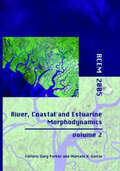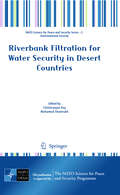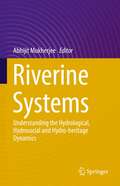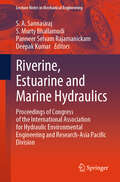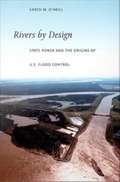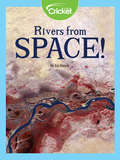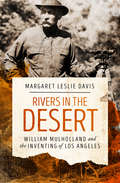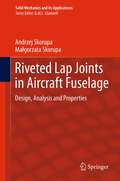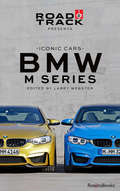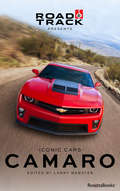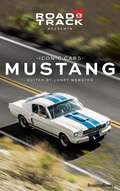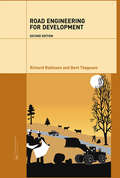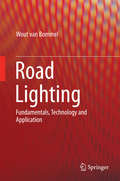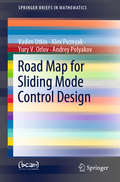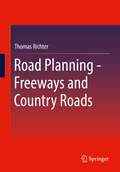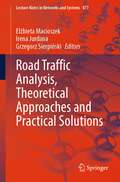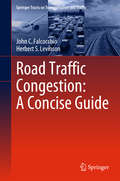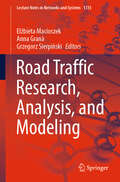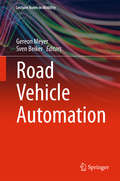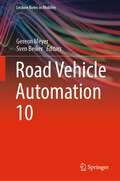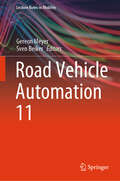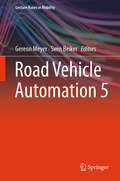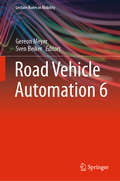- Table View
- List View
River, Coastal and Estuarine Morphodynamics: Proceedings of the 4th IAHR Symposium on River, Coastal and Estuarine Morphodynamics (RCEM 2005, Urbana, Illinois, USA, 4-7 October 2005)
by Gary Parker Marcelo H. GarcíaThe proceedings of the 4th Symposium on River, Coastal and Estuarine Morphodynamics offers the latest research results concerning quantitative modelling of the interaction of water and sediment and the shapes this interaction makes in rivers, watersheds, estuaries, the coast, the continental shelf and the deep sea. Morphodynamics is the study of the evolution of landscape and seascape features, from small scale to large.
Riverbank Filtration for Water Security in Desert Countries
by Chittaranjan Ray Mohamed ShamrukhRiverbank filtration is a low cost, yet efficient water treatment technology. It has most potential to provide safe drinking water to large cities located along rivers or lakes. In particular, it is ideal for large population centres in developing countries, where the cost of building extensive treatment facilities is prohibitive. Water filtration can be successfully implemented using naturally occurring sand and gravel along the river/lake banks. The cost of water produced by this means is much lower than that of water treated in conventional treatment plants. Authored by a multi-disciplinary team of experts, this volume addresses the scientific basis of the filtration process, and also numerous topics of importance for the planning, technical realization, and security of such plants. Their application for the removal of relevant chemical pollutants and a variety of pathogens is analysed in detail.
Riverine Systems: Understanding the Hydrological, Hydrosocial and Hydro-heritage Dynamics
by Abhijit MukherjeeThis book provides a unique opportunity to integrate the knowledge on regional-scale riverine reviews to local-scale case-studies, ranging from availability to pollution, national-level river management to transboundary governance. It is an unparalleled attempt to build the bridge between the science of rivers and its history and socio-politics, thus articulating the due credence of rivers from ancient civilizations to modern human societies. The chapters in this book are organized by the sub-sections of i) Hydrology, ii) Hydrosocial and iii) Hydro-heritage, thus providing a unique knowledge on the river studies for historians, scientists, planners, social scientists and policymakers, and are written by leading experts and researchers from across the globe.
Riverine, Estuarine and Marine Hydraulics: Proceedings of Congress of the International Association for Hydraulic Environmental Engineering and Research-Asia Pacific Division (Lecture Notes in Mechanical Engineering)
by Deepak Kumar S. A. Sannasiraj S. Murty Bhallamudi Panneer Selvam RajamanickamThis book comprises the select proceedings of the 23rd Congress of the International Association for Hydraulic Environmental Engineering and Research–Asia Pacific Division (IAHR-APD 2022). The book focuses on remote sensing and GIS applications, inter-basin transfer, flood modeling, water quality modeling, leak detection, contaminant transport modeling, recycling and reuse, micro pollutants, coastal erosion and protection, smart coastal cities, integrated coastal zone management, blue economy, risk assessment, climate modeling, and eco system-based design, etc. The book can be a valuable reference for researchers and professionals interested in the fields of hydraulic and environmental engineering.
Rivers by Design: State Power and the Origins of U.S. Flood Control
by Karen M. O'NeillThe United States has one of the largest and costliest flood control systems in the world, even though only a small proportion of its land lies in floodplains. Rivers by Design traces the emergence of the mammoth U. S. flood management system, which is overseen by the federal government but implemented in conjunction with state governments and local contractors and levee districts. Karen M. O'Neill analyzes the social origins of the flood control program, showing how the system initially developed as a response to the demands of farmers and the business elite in outlying territories. The configuration of the current system continues to reflect decisions made in the nineteenth century and early twentieth. It favors economic development at the expense of environmental concerns. O'Neill focuses on the creation of flood control programs along the lower Mississippi River and the Sacramento River, the first two rivers to receive federal flood control aid. She describes how, in the early to mid-nineteenth century, planters, shippers, and merchants from both regions campaigned for federal assistance with flood control efforts. She explains how the federal government was slowly and reluctantly drawn into water management to the extent that, over time, nearly every river in the United States was reengineered. Her narrative culminates in the passage of the national Flood Control Act of 1936, which empowered the Army Corps of Engineers to build projects for all navigable rivers in conjunction with local authorities, effectively ending nationwide, comprehensive planning for the protection of water resources.
Rivers from Space!
by Liz HuyckWhen on land, rivers, lakes, and oceans appear flat. With the aid of satellites, these bodies of water appear to have many designs! Explore the art of nature and how satellites detect the temperature of the many bodies of water around the globe.
Rivers in the Desert: William Mulholland and the Inventing of Los Angeles
by Margaret Leslie DavisThe rise and fall of William Mulholland, and the story of L.A.&’s disastrous dam collapse: &“A dramatic saga of ambition, politics, money and betrayal&” (Los Angeles Daily News). Rivers in the Desert follows the remarkable career of William Mulholland, the visionary who engineered the rise of Los Angeles as the greatest American city west of the Mississippi. He sought to transform the sparse and barren desert into an inhabitable environment by designing the longest aqueduct in the Western Hemisphere, bringing water from the mountains to support a large city. This &“fascinating history&” chronicles Mulholland&’s dramatic ascension to wealth and fame—followed by his tragic downfall after the sudden collapse of the dam he had constructed to safeguard the water supply (Newsweek). The disaster, which killed at least five hundred people, caused his repudiation by allies, friends, and a previously adoring community. Epic in scope, Rivers in the Desert chronicles the history of Los Angeles and examines the tragic fate of the man who rescued it. &“An arresting biography of William Mulholland, the visionary Los Angeles Water Department engineer . . . [his] personal and public dramas make for gripping reading.&” —Publishers Weekly &“A fascinating look at the political maneuvering and engineering marvels that moved the City of Angels into the first rank of American cities.&” —Booklist
Rivers of Empire: Water, Aridity, and the Growth of the American West
by Donald WorsterWhen Henry David Thoreau went for his daily walk, he would consult his instincts on which direction to follow. More often than not his inner compass pointed west or southwest. "The future lies that way to me," he explained, "and the earth seems more unexhausted and richer on that side. " In his own imaginative way, Thoreau was imitating the countless young pioneers, prospectors, and entrepreneurs who were zealously following Horace Greeley's famous advice to "go west. " Yet while the epic chapter in American history opened by these adventurous men and women is filled with stories of frontier hardship, we rarely think of one of their greatest problems--the lack of water resources. And the same difficulty that made life so troublesome for early settlers remains one of the most pressing concerns in the western states of the late-twentieth century. The American West, blessed with an abundance of earth and sky but cursed with a scarcity of life's most fundamental need, has long dreamed of harnessing all its rivers to produce unlimited wealth and power. In Rivers of Empire, award-winning historian Donald Worster tells the story of this dream and its outcome. He shows how, beginning in the mid-nineteenth century, Mormons were the first attempting to make that dream a reality, damming and diverting rivers to irrigate their land. He follows this intriguing history through the 1930s, when the federal government built hundreds of dams on every major western river, thereby laying the foundation for the cities and farms, money and power of today's West. Yet while these cities have become paradigms of modern American urban centers, and the farms successful high-tech enterprises, Worster reminds us that the costs have been extremely high. Along with the wealth has come massive ecological damage, a redistribution of power to bureaucratic and economic elites, and a class conflict still on the upswing. As a result, the future of this "hydraulic West" is increasingly uncertain, as water continues to be a scarce resource, inadequate to the demand, and declining in quality. Rivers of Empire represents a radically new vision of the American West and its historical significance. Showing how ecological change is inextricably intertwined with social evolution, and reevaluating the old mythic and celebratory approach to the development of the West, Worster offers the most probing, critical analysis of the region to date. He shows how the vast region encompassing our western states, while founded essentially as colonies, have since become the true seat of the American "Empire. " How this imperial West rose out of desert, how it altered the course of nature there, and what it has meant for Thoreau's (and our own) mythic search for freedom and the American Dream, are the central themes of this eloquent and thought-provoking story--a story that begins and ends with water.
Riveted Lap Joints in Aircraft Fuselage
by Andrzej Skorupa Małgorzata SkorupaFatigue of the pressurized fuselages of transport aircraft is a significant problem all builders and users of aircraft have to cope with for reasons associated with assuring a sufficient lifetime and safety, and formulating adequate inspection procedures. These aspects are all addressed in various formal protocols for creating and maintaining airworthiness, including damage tolerance considerations. In most transport aircraft, fatigue occurs in lap joints, sometimes leading to circumstances that threaten safety in critical ways. The problem of fatigue of lap joints has been considerably enlarged by the goal of extending aircraft lifetimes. Fatigue of riveted lap joints between aluminium alloy sheets, typical of the pressurized aircraft fuselage, is the major topic of the present book. The richly illustrated and well-structured chapters treat subjects such as: structural design solutions and loading conditions for fuselage skin joints; relevance of laboratory test results for simple lap joint specimens to riveted joints in a real structure; effect of various production and design related variables on the riveted joint fatigue behaviour; analytical and experimental results on load transmission in mechanically fastened lap joints; theoretical and experimental analysis of secondary bending and its implications for riveted joint fatigue performance; nucleation and shape development of fatigue cracks in riveted longitudinal lap joints; overview of experimental investigations into the multi-site damage for full scale fuselage panels and riveted lap joint specimens; fatigue crack growth and fatigue life prediction methodology for riveted lap joints; residual strength predictions for riveted lap joints in a fuselage structure. The major issues of each chapter are recapitulated in the last section.
Road & Track Iconic Cars: BMW M Series (Road & Track Iconic Cars)
by Larry WebsterFully illustrated with color photography, this eBook collects Road & Track&’s coverage of the acclaimed BMW M Series from 1985 to 2014. Since it debuted the BMW E2 in 1972, the legendary German car brand has taken a balanced approach to its M series cars, turning already competitive models into well-rounded, capable performance machines. Year after year, BMW&’s Motorsport division has set the standard for power, style, and overall excellence. This eBook collects Road & Track&’s BMW M car coverage, including features, reviews, comparison tests, and interviews on everything from the M3 and M5 to the short-lived M1 supercar, and even the recent M-badged SUVs. Taken together, the nearly thirty years of expert automotive writing presents a critical history of BMW&’s design and engineering achievements.
Road & Track Iconic Cars: Camaro (Road & Track Iconic Cars)
by Larry WebsterThis fully illustrated eBook collects more than 30 years of articles and reviews on the classic American coupe from the experts at Road & Track. Since the Camaro debuted in 1966, the Chevy coupe&’s combination of high style, stout performance, and affordable price have made it an automotive icon. This eBook, compiled from the pages of Road & Track magazine, takes readers inside the launch, the racers, the duds, and, of course, the Camaro&’s triumphant return. Packed with photographs, this volume covers the classic Chevy from the 1968 Camaro Z-28 to 2001&’s Camaro SS. It features road tests, reviews, feature stories, and comparisons from the automotive experts who know best, along with interviews with the folks behind the Camaro and columns from Matt DeLorenzo and Peter Egan.
Road & Track Iconic Cars: Mustang (Road & Track Iconic Cars)
by Larry WebsterThis eBook collects 50 years of articles and reviews on the iconic American sportscar from the experts at Road & Track. Nothing says America like the Ford Mustang, the original pony car and the country&’s most beloved sporting machine. This fully illustrated volume, pulled from the pages of Road & Track, documents the rise of this automotive icon—the brainchild of crude engineering, modern styling, and fantastic marketing. This eBook looks back across 50 years of coverage, from recaps of Ford&’s game-changing win at Le Mans in 1966 to the dark years of the Mustang II. There are road tests, comparisons, and reviews from the R&T archives. Taken as a whole, this half-century of automotive journalism demonstrates why the car that defined a generation continues to mean so much to so many.
Road Engineering for Development
by Richard Robinson Bent ThagesenDeveloping countries in the tropics have different natural conditions and different institutional and financial situations to industrialized countries. However, most textbooks on highway engineering are based on experience from industrialized countries with temperate climates, and deal only with specific problems.Road Engineering for Development (published as Highway and Traffic Engineering in Developing Countries in its first edition) provides a comprehensive description of the planning, design, construction and maintenance of roads in developing countries. It covers a wide range of technical and non-technical problems that may confront road engineers working in this area. The technical content of the book has been fully updated and current development issues are focused on.Designed as a fundamental text for civil engineering students this book also offers a broad, practical view of the subject for practising engineers. It has been written with the assistance of a number of world-renowned specialist professional engineers with many years experience in Africa, the Middle East, Asia and Central America.
Road Lighting
by Wout Van BommelThis book outlines the underlying principles on which modern road lighting is based, and provides the reader with knowledge of how these principles should be applied in practice. This book offers a completely fresh approach to the subject, reflecting how the technology of road lighting has progressed to keep up with the changes in lamp technology, especially in solid state light sources, and the increasing awareness of energy use and environmental issues. The book is divided into three parts. Part One describes lighting of open roads, with chapters discussing visual performance and comfort (including the effects of mesopic vision and age), and international standards and recommendations for road lighting. Lighting equipment is introduced; specifically lamps and luminaires in terms of their practical properties and features, but also the road surface and its characteristics. A chapter on Lighting Design makes the link between theory and practice, providing the reader with the knowledge needed for effective lighting design, including aspects relating to sustainability. The final chapter of Part One deals with lighting calculation conventions and measurements. Part Two is devoted to light pollution. The negative consequences of light pollution are described and tactics to restrict light pollution explained. Lighting criteria are defined that can be used by the lighting designer to guarantee installations stay within acceptable limits. International standards and recommendations on the restriction of light pollution are discussed. Part Three is devoted to tunnel lighting, with chapters discussing visual performance in tunnel environments, lighting criteria, standards and recommendations, and concluding with a chapter on tunnel lighting equipment and design. This book is a valuable resource for road lighting designers and engineers, students of lighting design and engineering, town planners, traffic engineers, environmental specialists, and lamp and luminaire developers and manufacturers.
Road Map for Sliding Mode Control Design (SpringerBriefs in Mathematics)
by Yury V. Orlov Andrey Polyakov Vadim Utkin Alex PoznyakThis book is devoted to control of finite and infinite dimensional processes with continuous-time and discrete time control, focusing on suppression problems and new methods of adaptation applicable for systems with sliding motions only. Special mathematical methods are needed for all the listed control tasks. These methods are addressed in the initial chapters, with coverage of the definition of the multidimensional sliding modes, the derivation of the differential equations of those motions, and the existence conditions. Subsequent chapters discusses various areas of further research. The book reflects the consensus view of the authors regarding the current status of SMC theory. It is addressed to a broad spectrum of engineers and theoreticians working in diverse areas of control theory and applications. It is well suited for use in graduate and postgraduate courses in such university programs as Electrical Engineering, Control of Nonlinear Systems, and Mechanical Engineering.
Road Planning - Freeways and Country Roads
by Thomas RichterThe book covers the planning and design of highways and country roads. The quality requirements for the road are derived from the network planning. After an excursus into the fundamentals of driving dynamics, the design elements are described in the site plan, in the height plan and in cross-section. After a detailed presentation of the intersection solutions, the necessary equipment is compiled.This book is a translation of the original German 1st edition Planung von Autobahnen und Landstraßen by Richter Thomas published by Springer Fachmedien Wiesbaden GmbH, part of Springer Nature in 2016. The translation was done with the help of artificial intelligence (machine translation by the service DeepL.com). A subsequent human revision was done primarily in terms of content, so that the book will read stylistically differently from a conventional translation. Springer Nature works continuously to further the development of tools for the production of books and on the related technologies to support the authors.
Road Terrain Classification Technology for Autonomous Vehicle (Unmanned System Technologies)
by Shifeng WangThis book provides cutting-edge insights into autonomous vehicles and road terrain classification, and introduces a more rational and practical method for identifying road terrain. It presents the MRF algorithm, which combines the various sensors’ classification results to improve the forward LRF for predicting upcoming road terrain types. The comparison between the predicting LRF and its corresponding MRF show that the MRF multiple-sensor fusion method is extremely robust and effective in terms of classifying road terrain. The book also demonstrates numerous applications of road terrain classification for various environments and types of autonomous vehicle, and includes abundant illustrations and models to make the comparison tables and figures more accessible.
Road Traffic Analysis, Theoretical Approaches and Practical Solutions (Lecture Notes in Networks and Systems #877)
by Elżbieta Macioszek Grzegorz Sierpiński Irena JurdanaThis book presents many valuable tips for making decisions related to road traffic in transport networks. The knowledge base in practical examples, as well as the decision support systems described in this volume, finds interest among people who face the daily challenge of searching for advanced solutions and practical applications in road traffic engineering. The publication is therefore addressed to local authorities related to the planning and development of development strategies for selected areas with regard to transport (both in the urban and regional dimension) and to representatives of business and industry, as people directly involved in the implementation of traffic engineering solutions. The tips contained in individual sections of the publication allow to look at a given problem in an advanced way and facilitate the selection of the appropriate strategy (among others, in relation to the heuristic approach to assessing the performance efficiency of road intersections in urban environments from the resilience perspective, modeling the distribution of transport pollutants in a naturally ventilated road tunnel, development of a camera-based parking monitoring system with an automatic parking spot identification). In turn, due to a new approach to theoretical models (including, inter alia, problems with the safety of passengers at tram stops or energy-efficient radio platforms for the implementation of nodes of sensor networks), the publication also interests scientists and researchers carrying out research in this area. The publication entitled "Road Traffic Analysis, Theoretical Approaches and Practical Solutions" contains selected papers submitted to and presented at the 19th “Transport Systems. Theory and Practice” Scientific and Technical Conference organized by the Department of Transport Systems, Traffic Engineering and Logistics at the Faculty of Transport and Aviation Engineering at the Silesian University of Technology. The conference took place on September 18–19, 2023, in Katowice (Poland).
Road Traffic Congestion: A Concise Guide
by John C. Falcocchio Herbert S. LevinsonThis book on road traffic congestion in cities and suburbs describes congestion problems and shows how they can be relieved. The first part (Chapters 1 - 3) shows how congestion reflects transportation technologies and settlement patterns. The second part (Chapters 4 - 13) describes the causes, characteristics, and consequences of congestion. The third part (Chapters 14 - 23) presents various relief strategies - including supply adaptation and demand mitigation - for nonrecurring and recurring congestion. The last part (Chapter 24) gives general guidelines for congestion relief and provides a general outlook for the future. The book will be useful for a wide audience - including students, practitioners and researchers in a variety of professional endeavors: traffic engineers, transportation planners, public transport specialists, city planners, public administrators, and private enterprises that depend on transportation for their activities.
Road Traffic Research, Analysis, and Modeling (Lecture Notes in Networks and Systems #1315)
by Elżbieta Macioszek Grzegorz Sierpiński Anna GranàThis volume presents many valuable tips for making decisions related to road traffic in transport networks. The knowledge base in practical examples, as well as the decision support systems described in this volume, will find interest among people who face the daily challenge of searching for solutions in the area of road traffic research, analysis, and modeling. The publication is therefore addressed to local authorities related to the planning and development of strategies for selected areas with regard to transport (both in the urban and regional dimension), and to representatives of business and industry, as people directly involved in the implementation of traffic engineering solutions. The tips contained in individual sections of the publication will allow to look at a given problem in an advanced way and facilitate the selection of the appropriate strategy (among others, in relation to the smart mobility operation at signalized intersection level, studies the influence of health on travel mode choice to work, enhanced bl-based positioning system in road, estimation of energy consumption in case of a special off-road vehicle for people with special needs or the use of large data sets known as big data in modeling and traffic management processes). In turn, due to a new approach to theoretical models (including, inter alia, problems of pedestrian traffic on a pedestrian drawbridge, preference of electric cars using traffic lights, as well as probability of vehicle collision with road safety barriers), the publication will also interest scientists and researchers carrying out research in this area. The publication entitled "Road Traffic Research, Analysis, and Modeling" contains selected papers submitted to and presented at the 20th ”Transport Systems. Theory and Practice” Scientific and Technical Conference organized by the Department of Transport Systems, Traffic Engineering and Logistics at the Faculty of Transport and Aviation Engineering at the Silesian University of Technology. The conference took place on September 10-11, 2024 in Katowice (Poland).
Road Vehicle Automation (Lecture Notes In Mobility Ser.)
by Gereon Meyer Sven BeikerThis contributed volume covers all relevant aspects of road vehicle automation including societal impacts, legal matters, and technology innovation from the perspectives of a multitude of public and private actors. It is based on an expert workshop organized by the Transportation Research Board at Stanford University in July 2013. The target audience primarily comprises academic researchers, but the book may also be of interest to practitioners and professionals. Higher levels of road vehicle automation are considered beneficial for road safety, energy efficiency, productivity, convenience and social inclusion. The necessary key technologies in the fields of object-recognition systems, data processing and infrastructure communication have been consistently developed over the recent years and are mostly available on the market today. However, there is still a need for substantial research and development, e.g. with interactive maps, data processing, functional safety and the fusion of different data sources. Driven by stakeholders in the IT industry, intensive efforts to accelerate the introduction of road vehicle automation are currently underway.
Road Vehicle Automation 10 (Lecture Notes in Mobility)
by Gereon Meyer Sven BeikerThis book is the tenth volume of a sub-series on Road Vehicle Automation, published as part of the Lecture Notes in Mobility. It gathers contributions to the Automated Road Transportation Symposium (ARTS 2022), held on July 18-21, 2022, in Garden Grove, USA, CA. Written by researchers, engineers and analysts from around the globe, this book offers a multidisciplinary perspectives on the opportunities and challenges associated with automating road transportation. It highlights innovative strategies, including public policies, infrastructure planning and automated technologies, which are expected to foster sustainable and automated mobility in the near future, thus addressing industry, government and research communities alike.
Road Vehicle Automation 11 (Lecture Notes in Mobility)
by Gereon Meyer Sven BeikerThis book is the eleventh volume of a sub-series on Road Vehicle Automation, published as part of the Lecture Notes in Mobility. It gathers original peer-reviewed works based on contributions to the plenary and breakout sessions of the Automated Road Transportation Symposium (ARTS 2023), held on July 9-13, 2023, in San Francisco, CA, USA. The chapters were selected and reviewed by the book editors, together with a number of experts in automated mobility, who were also involved in organizing different sessions at the above-mentioned conference. Written by researchers, engineers and analysts from around the globe, this book offers multidisciplinary perspectives on the opportunities and challenges associated with automating road transportation. It highlights innovative strategies, including public policies, infrastructure planning and automation technologies, which are expected to foster more sustainable and safer mobility in the near future, thereby addressing industry, government and research communities alike.
Road Vehicle Automation 5 (Lecture Notes in Mobility)
by Gereon Meyer Sven BeikerThis is the fifth volume of a sub series on Road Vehicle Automation published within the Lecture Notes in Mobility. Like in previous editions, scholars, engineers and analysts from all around the world have contributed chapters covering human factors, ethical, legal, energy and technology aspects related to automated vehicles, as well as transportation infrastructure and public planning. The book is based on the Automated Vehicles Symposium which was hosted by the Transportation Research Board (TRB) and the Association for Unmanned Vehicle Systems International (AUVSI) in San Francisco, California (USA) in July 2017.
Road Vehicle Automation 6 (Lecture Notes in Mobility)
by Gereon Meyer Sven BeikerThis is the sixth volume of a sub series on Road Vehicle Automation published within the Lecture Notes in Mobility. The contents have been provided by researchers, engineers and analysts from all around the world. Topics covered include public sector activities, human factors and challenges, ethical, legal, energy and technology perspectives, vehicle systems development, as well as transportation infrastructure and planning. The book is based on the Automated Vehicles Symposium held on July 9-12, 2018 in San Francisco, CA (USA).
